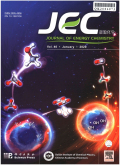- 钛学术文献服务平台 \
- 学术期刊 \
- 工业技术期刊 \
- 石油与天然气工业期刊 \
- 能源化学期刊 \
Lithium-ion mobility in layered oxides Li2Ca1.5Nb3O10,Li2Ca1.5TaNb2O10 and Li2Ca1.5Ta2NbO10,enhanced by supercell formation
Lithium-ion mobility in layered oxides Li2Ca1.5Nb3O10,Li2Ca1.5TaNb2O10 and Li2Ca1.5Ta2NbO10,enhanced by supercell formation
基本信息来源于合作网站,原文需代理用户跳转至来源网站获取
摘要:
The formation of a supercell and its impact on lithium-ion conductivity have been studied through syn-thesis of three layered oxides,Li2Ca1.5Nb3O10,Li2Ca1.5TaNb2O10 and Li2Ca1.5Ta2NbO10,related to Ruddlesden-Popper structure-type.Neutron diffraction experiments show that these materials feature a supercell,which is significantly larger(~√2a×~√2b×~1 c)than that of a typical Ruddlesden-Popper oxide.Electrochemical impedance spectroscopy shows that the formation of the new supercell is associated with enhanced lithium-ion conductivity of these materials as compared with the Sr-analogue,Li2Sr1.5Nb3O10,which lacks the supercell.In addition,a systematic trend is observed in the ionic conductivity:Li2Ca1.5Ta2NbO10<Li2Ca1.5TaNb2O10<Li2Ca1.5Nb3O10.The Arrhenius analysis in the tem-perature range 25-400℃shows that activation energy for the temperature-dependent rise in conductiv-ity follows a similar trend.Detailed analyses of real and imaginary components of impedance,dielectric properties,tangent loss,and complex modulus show the systematic increase in lithium-ion mobility.The dielectric values mirror the same trend as ionic conductivity,where the most conductive material shows the highest dielectric properties.In addition,the same trend is observed in the peak and dispersion of dielectric loss and complex modulus as a function of angular frequency,indicating a systematic rise in lithium-ion mobility.This fundamental study is aimed at exploring the impact of structural modifications on ionic conductivity in solids.

推荐文章
Li2O·Al2O3·SiO2复相陶瓷的研制
石英砂
Li2CO3掺杂
锂辉石陶瓷
微观结构
力学性能
稀土La2O3对Li2O-A12O3-SiO2微晶玻璃结构和性能的影响
氧化镧
微晶玻璃
显微结构
抗折强度
基于组分Ca2Pr2Cu5O10三元固溶区的范围和晶体结构
Ca2Pr2Cu5O10
三元固溶区
X射线衍射
Rietveld结构精修
晶体结构
热处理对Li2O-Al2O3-SiO2微晶玻璃的影响
热处理
微晶玻璃
β-石英固溶体
β-锂辉石固溶体
内容分析
关键词云
关键词热度
相关文献总数
(/次)
(/年)
引文网络
引文网络
二级参考文献 (0)
共引文献 (0)
参考文献 (1)
节点文献
引证文献 (0)
同被引文献 (0)
二级引证文献 (0)
2006(1)
- 参考文献(1)
- 二级参考文献(0)
2021(0)
- 参考文献(0)
- 二级参考文献(0)
- 引证文献(0)
- 二级引证文献(0)
引文网络交叉学科
相关学者/机构
期刊影响力
能源化学
主办单位:
中国科学院大连化学物理研究所
中国科学院成都有机化学研究所
出版周期:
双月刊
ISSN:
2095-4956
CN:
10-1287/O6
开本:
出版地:
大连市中山路457号
邮发代号:
创刊时间:
语种:
eng
出版文献量(篇)
2804
总下载数(次)
0
总被引数(次)
7996
期刊文献
相关文献
推荐文献
- 期刊分类
- 期刊(年)
- 期刊(期)
- 期刊推荐
一般工业技术
交通运输
军事科技
冶金工业
动力工程
化学工业
原子能技术
大学学报
建筑科学
无线电电子学与电信技术
机械与仪表工业
水利工程
环境科学与安全科学
电工技术
石油与天然气工业
矿业工程
自动化技术与计算机技术
航空航天
轻工业与手工业
金属学与金属工艺
能源化学2022
能源化学2021
能源化学2020
能源化学2019
能源化学2018
能源化学2017
能源化学2016
能源化学2015
能源化学2014
能源化学2013
能源化学2012
能源化学2011
能源化学2010
能源化学2009
能源化学2008
能源化学2007
能源化学2006
能源化学2005
能源化学2004
能源化学2003
能源化学2002
能源化学2001
能源化学2021年第9期
能源化学2021年第8期
能源化学2021年第7期
能源化学2021年第6期
能源化学2021年第5期
能源化学2021年第4期
能源化学2021年第3期
能源化学2021年第2期
能源化学2021年第12期
能源化学2021年第1期

 免费查重
免费查重










